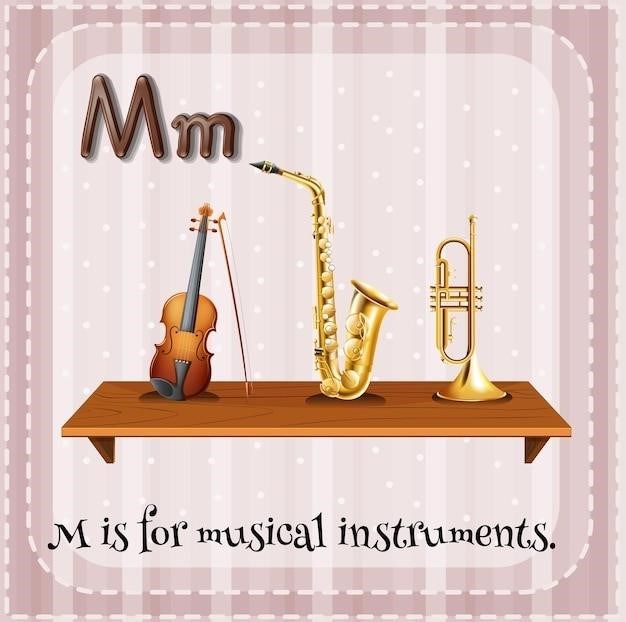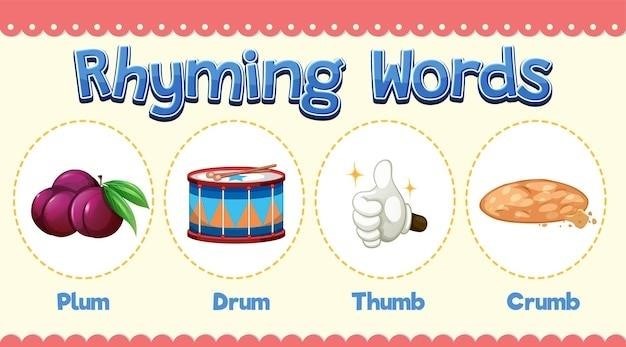What are Homophones?
Homophones are words that sound the same but have different meanings and spellings. For example, “to,” “too,” and “two” are all pronounced the same, but they have different meanings. Homophones can be tricky to use correctly in writing and speech, but understanding them is essential for good communication.
Definition of Homophones
Homophones are words that sound alike but have different meanings and spellings. They can be tricky to use correctly, but understanding them is essential for good communication. For example, “to,” “too,” and “two” are all pronounced the same, but they have different meanings. This list of homophones focuses specifically on words related to musical instruments, helping you avoid common spelling errors and improve your writing and speaking skills.
Examples of Homophones
Here are some examples of homophones related to musical instruments that can easily be confused⁚
- Bass (the low-pitched stringed instrument) vs. Base (the foundation or bottom part of something)
- Chord (a combination of musical notes played together) vs. Cord (a string or rope)
- Key (a note on a musical keyboard) vs. Key (a device used to open a lock)
- Lead (a musical part played by the main singer or instrumentalist) vs. Led (past tense of “to lead”)
These are just a few examples, and there are many other homophones related to musical instruments. Understanding these differences is crucial for clear and accurate communication about music.
Why are Homophones Important?
Homophones are important because they can easily lead to misunderstandings in written and spoken communication, especially when discussing specific musical instruments.
Common Mistakes with Homophones
One common mistake is using “bass” (the low-pitched instrument) instead of “base” (the bottom part of something). For example, you might write “He plays the bass guitar,” when you actually mean “He plays the base guitar.” Another frequent error is using “chord” (a musical harmony) instead of “cord” (a string or rope). A sentence like “The guitarist strummed a chord” is correct, while “The guitarist strummed a cord” is grammatically incorrect. These mistakes can make your writing sound unprofessional or even confusing.
Furthermore, using “lead” (a metal) instead of “led” (past tense of “lead”) can also be a common issue. For example, “The band was led by a talented musician” is correct, while “The band was lead by a talented musician” is grammatically incorrect. It’s essential to pay close attention to the context and meaning of the words to avoid these common homophone mistakes;
Homophones in Writing and Speech
Homophones can be particularly tricky in writing, as they are only differentiated by their spelling. For example, if you are writing about a musical instrument, you must carefully choose between “bass” and “base” to ensure clarity. In speech, homophones are often easier to distinguish, as the context and tone of voice can help listeners understand the intended meaning. However, even in speech, homophones can lead to misunderstandings, especially when spoken quickly or casually.
Understanding the nuances of homophones and their correct usage is crucial for effective communication, whether written or spoken. By carefully considering the context and the intended meaning, you can avoid these pitfalls and ensure that your message is clear and accurate.

Lists of Homophones
There are many resources available that provide comprehensive lists of homophones, including online resources and downloadable PDF files.
Free Online Resources
The internet offers a wealth of free resources for those seeking to learn more about homophones. Websites such as EnglishClub.com provide comprehensive lists of homophones, often categorized by phonetic sound. These resources can be particularly helpful for students and learners of English, providing a quick and easy way to access information. Many websites also offer interactive exercises and quizzes to help users practice recognizing and using homophones correctly. This interactive approach can make learning more engaging and effective.
PDF Downloads
For those who prefer a more portable and offline resource, numerous PDF downloads containing extensive homophone lists are available online. These PDFs often provide a comprehensive collection of homophone pairs, sometimes exceeding 400 entries. Some resources categorize homophones by their phonetic sounds, making it easier for users to navigate and identify similar-sounding words. These downloadable PDFs are particularly useful for students, teachers, and anyone seeking a quick reference guide for homophones. They offer a convenient way to access and review homophone lists whenever and wherever needed.
Homophones by Category
Organizing homophones by category can significantly enhance their learning and understanding. Some online resources categorize homophones based on their specific areas of usage, such as musical instruments, common everyday words, or academic terms. This approach allows users to focus on specific categories relevant to their needs. For instance, a musician might be interested in homophones related to musical instruments, while a student preparing for an exam might focus on homophones frequently encountered in academic writing. By categorizing homophones, learners can effectively target specific areas of interest and improve their vocabulary within those contexts.

Using Homophones Effectively
Mastering homophones requires a combination of careful attention to context, dictionary checks, and consistent practice.
Context Clues
One of the most effective ways to use homophones correctly is to pay attention to the context in which they are used. For example, if you see the word “to” in a sentence, it’s likely that it’s being used as a preposition, meaning “towards” or “in the direction of.” But if you see the word “too” in a sentence, it’s likely that it’s being used as an adverb, meaning “also” or “very.” Similarly, the word “two” is typically used to indicate the number 2.
By paying attention to the words around the homophone, you can often figure out which word is being used and what its meaning is. This is especially important when you’re reading or writing about music, as instrument homophones can sometimes be tricky to distinguish.
Dictionary Check
If you’re still unsure about which homophone to use, a dictionary can be a valuable resource. A dictionary will provide you with the definitions of each word, as well as examples of how they are used in sentences. This can help you to understand the nuances of each word and choose the one that best fits the context of your writing.
Many online dictionaries also have audio pronunciations of words, which can be helpful if you’re unsure how to pronounce a particular homophone. This can help you to avoid using the wrong word, even if you’re not sure how to spell it correctly.
Practice and Memorization
The best way to learn and remember homophones is through practice and memorization. There are many ways to do this, including creating flashcards, playing word games, or simply reading and writing as much as possible. When you encounter a homophone, take a moment to think about its meaning and how it’s used in context.
You can also try to create your own sentences using different homophones. This will help you to understand how they are used in different situations. By practicing regularly, you’ll become more familiar with the correct spellings and meanings of homophones, and you’ll be less likely to make mistakes in your writing and speech.
Homophones are an integral part of the English language, adding richness and complexity to our communication. By understanding and using them correctly, we can enhance our writing and speaking skills, making our communication clearer and more effective.
Importance of Homophones in Language
Homophones, despite their potential to cause confusion, play a vital role in enriching the English language. They contribute to the richness and complexity of our vocabulary, offering multiple ways to express similar concepts. This diversity allows for subtle nuances in meaning and adds depth to our written and spoken communication. For instance, the words “write” and “right” sound identical, but convey distinct meanings, allowing for precision in conveying our thoughts. Furthermore, homophones often contribute to humor and wordplay, making language more engaging and entertaining. They can also serve as a valuable tool for creative expression in poetry, songwriting, and other forms of artistic writing.
Further Exploration
The world of homophones extends far beyond the examples provided in this document. To delve deeper into this fascinating linguistic phenomenon, consider exploring online resources such as the “Homophones List in English A to Z pdf” available on EnglishClub.com. This comprehensive list includes hundreds of homophone pairs, categorized alphabetically for easy reference. Additionally, consider exploring the Etymology of English words, which can provide insights into how homophones developed over time. For a more interactive approach, try engaging in word games and puzzles that focus on homophones. These activities can help you learn new homophones and improve your ability to use them correctly in your writing and speech.
Leave a Reply
You must be logged in to post a comment.